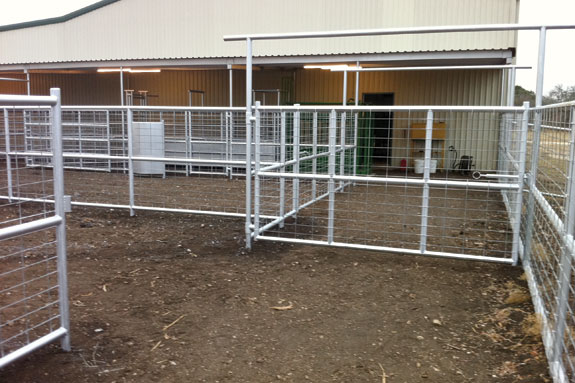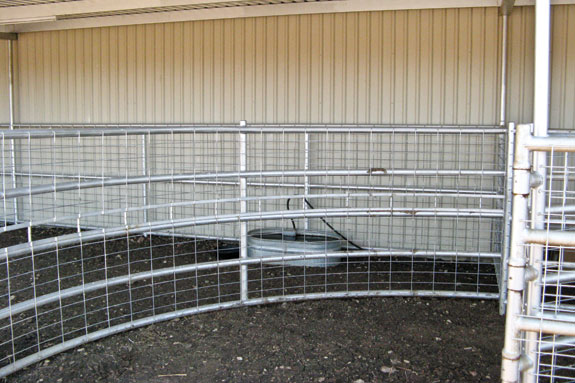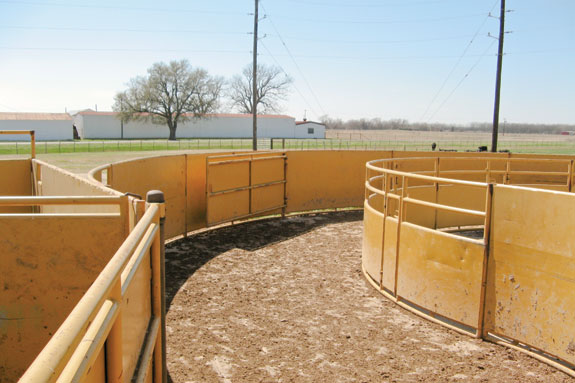In addition, stress often causes abortions and injuries to animals and employees. Cattle stress is reduced by using proper handling techniques and facilitated with corrals designed for smooth animal flow.
Manage flow
“Corral design should allow working cattle by their natural flow,” stated Ron Gill with Texas AgriLife Extension Service.
“When cattle come from a pasture through the holding pen gate, there should be a second gate behind the animals.
Their natural instinct is to turn around and come back out. If the next open gate is adjacent to the one you just closed, cattle will naturally flow through it without being pressured, because that is the direction they want to go.
Always design pens where you don’t have to get behind the cattle. Work from their sides where they can see you. This action maintains cattle flow and that is the objective.”

“A good corral design allows sorting from the squeeze chute without disrupting the flow of cattle entering the working area,” Raymond Huhnke and Sam Harp wrote in Texas Agricultural Extension Service Bulletin BCM-49.
“Pens interconnected with a common alleyway accessed from the squeeze chute provide ideal sorting capabilities.
Cattle can be held in the alleyway and sorted into any of the adjacent pens. Maximum width for a common alleyway used to sort cattle is 12 feet. The alleyway can also be used to confine cattle for spraying.”
Bud Box or a tub?
The decision of whether to use a Bud Box or a tub for a crowding pen is basically a matter of personal preference.

A Bud Box is simply a small rectangular corral named after Bud Williams, one of the livestock low-stress-handling pioneers.
Williams used it on a ranch he managed and has since built and promoted Bud Boxes for ranchers willing to work cattle using the techniques he taught.
“If it is properly designed and the handler works it correctly, cattle flow into the Bud Box, hit a dead end and then turn back in the direction from which they came,” explains Gill.
“After the cattle turn, they flow into the crowd alley single file as long as someone is standing in the correct position near the entrance.”
Temple Grandin of Colorado State University says that a round crowd pen or tub needs to be designed for taking advantage of cattle’s tendency to go back in the same direction from which they came.
To accomplish this, the crowd pen is built in a 180-degree arc, which makes cattle think they are going back to their point of entry.
“Although solid sides are common on Bud Boxes and tubs, I prefer that only the lower halves be covered,” Gill states.
“It is critical to cattle flow that a Bud Box not be solid on the outside end. Open top halves allow cattle to see the handler on the opposite side of the fence where he controls flow.
Working cattle from the outside avoids the necessity of having to get behind the animals.”
Gill says that a Bud Box or tub needs to be large enough to hold the number of cattle needed to fill the crowd alley.
Cattle should never be left in the box or tub after the crowd alley is filled. Any remaining cattle should be allowed to go back into the holding pen.
Straight or curved crowd alley?
“The crowd alley is the chute leading from the Bud Box or tub to the squeeze chute,” Gill further explains.
 “For cows it is between 24 and 32 inches wide, depending upon the size of the animals being worked. Like the Bud Box or tub, it is better to use half-panels to cover the bottom of the crowd alley sides than building complete solid walls.
“For cows it is between 24 and 32 inches wide, depending upon the size of the animals being worked. Like the Bud Box or tub, it is better to use half-panels to cover the bottom of the crowd alley sides than building complete solid walls.
The half-panels allow cattle to see you, which allows flow control while standing at their sides.
“Curved crowd alleys are very popular, but the problem is that people tend to start the curve right out of the Bud Box or tub.
To take advantage of a cow’s natural instinct, the crowd alley initially needs to be straight for at least two cow-lengths.
This allows a cow to follow another into the crowd alley before it starts curving. Once the crowd alley starts curving, it looks like a dead-end to a cow. As long as they have other animals following them, they don’t mind going around the curve.”
A curved crowd alley has its advantages. The person working the crowd alley can walk directly across from the tub or box to the squeeze chute without stopping cattle flow.
A curved alley also saves steps for a person working both the crowd alley and squeeze chute. Gill feels that the curved crowd alley was adopted because people think cattle like to move in a circle.
They only move in this fashion when they are trying to keep an eye on you. Cattle can see everywhere but directly behind them or a small blind spot in front. Movement behind a cow causes the animal to turn her head to keep you in her line of sight.
What else do you need?
Other than certain weaning practices, the greatest stress on cattle can be shipping and marketing. That is why it is important to have a good loading chute that facilitates a natural flow of cattle from the sorting pen into the trailer.
The chute’s floor height should be adjustable to accommodate both trucks and trailers unless a separate trailer loading facility is constructed.
“Corral construction costs should fit the ranch budget and the design should accommodate ranch operations and herd sizes,” states Rusty Alexander of Alexander Livestock Equipment.
“An excellent design on one ranch may not work as well on the neighbor’s ranch. So spend ample time planning before building.” ![]()
PHOTOS:
Top: Corrals built by Gary Davis on the family ranch near Georgetown, Texas. Cattle can be separated in three different pens from the sorting alley.
Middle Top: Cattle leave the squeeze chute and move into the sorting alley. All gates swing 180 degrees.
Middle Bottom: A tub with entrance into the crowding alley in the corrals.
Bottom: Tub leading into the crowding alley on one of the Texas A&M beef cattle farms. Photos by Gary Davis & Robert Fears.







